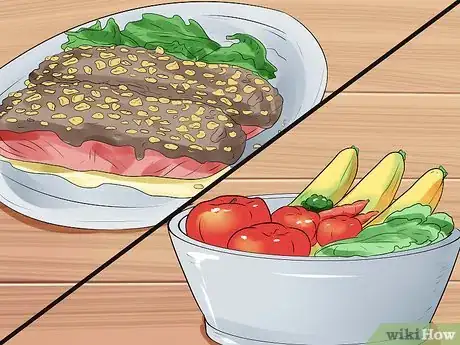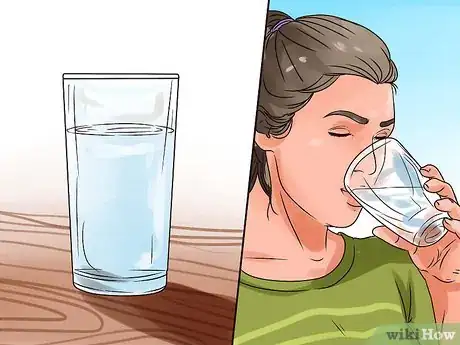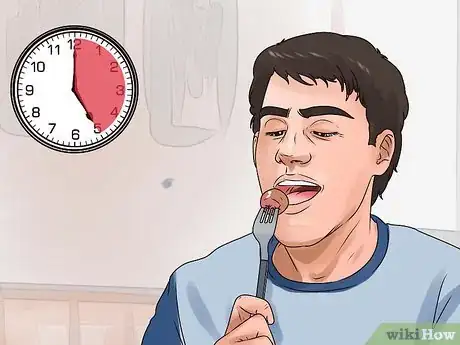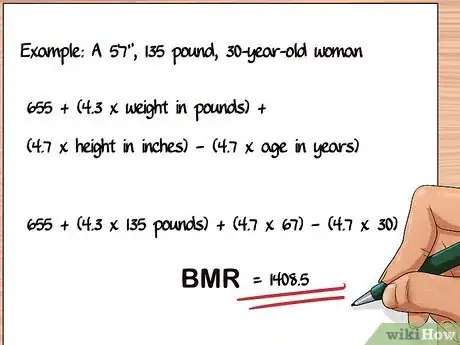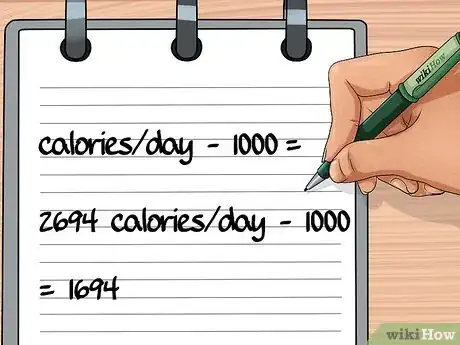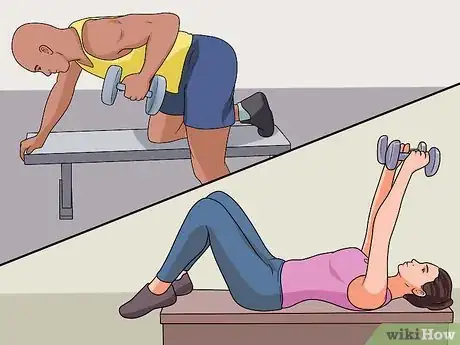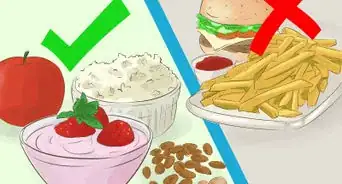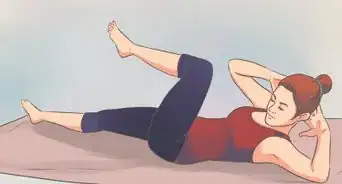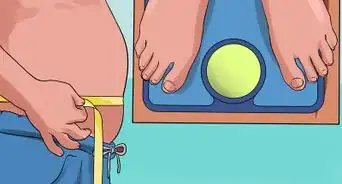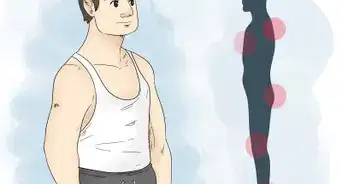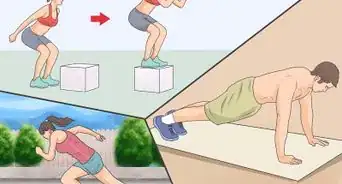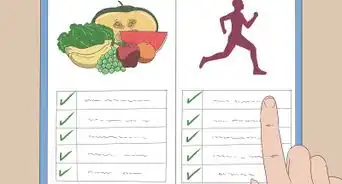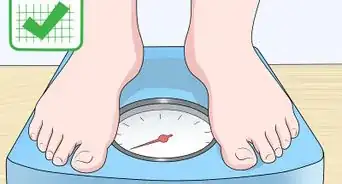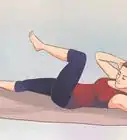This article was co-authored by Melody Sayers, MS, RD, NASM-CPT. Melody Sayers is a Registered Dietitian and NASM (National Academy of Sports Medicine) Certified Personal Trainer. She is the owner of Elevate Your Plate®, a private nutrition counseling and personal training practice, focused on an evidence-based, individualized, realistic, and results-driven approach to improving one's health. With over 8 years of experience, Melody has worked in both the private and public health sectors, helping both individuals and communities achieve milestones in managing their weight and preventing disease. She currently holds a Certificate in Adult Weight Management and a Master of Science in Nutrition, Dietetics, and Food Science from the California State University - Northridge.
There are 17 references cited in this article, which can be found at the bottom of the page.
wikiHow marks an article as reader-approved once it receives enough positive feedback. In this case, 100% of readers who voted found the article helpful, earning it our reader-approved status.
This article has been viewed 517,727 times.
Losing weight can be difficult. Slower weight loss or losing about 1–2 pounds weekly is ideal, safe and the most sustainable weight loss long-term.[1] You'll need to cut calories, eat the right types of foods, be active and possibly modify other lifestyle behaviors. That being said, losing weight can also be one of the most rewarding things you ever do. From better health and a longer life, to improved self-esteem, taking off the extra weight is worth it. Change your diet, add in physical activity, and modify your lifestyle to help you lose 2 pounds per week.
Steps
Eating Well
-
1Fill up on lean protein, fruits, and vegetables. Combining them at most meals can help you lose weight. According to registered dietician Melody Sayers, "Fiber-rich foods like fruits, veggies, and plant-based protein help you stay satisfied for longer." She also stresses how "plant-based protein sources have no cholesterol and practically no saturated fats."
- When you're trying to lose weight and cut calories, you'll need to choose nutrient-dense foods. These are items that are relatively low in calories, but also high in nutrients.
- Include one to two servings of fruits or vegetables at each meal. Make sure to measure your portions to 1/2 cup of fruit,[2] 1 cup of vegetables and 2 cups of leafy greens.[3]
- Protein is another type of food that can help you feel satisfied longer throughout the day and moderate your appetite. It also helps support your metabolism during the day.[4]
- Include a source of lean protein like chicken, fish, tofu, beans, shellfish, or low-fat dairy at each meal. Stick to a 3–4 oz portion of these lean proteins.[5]
-
2Eat moderate amounts of whole grains. Including a few servings of whole grains helps balance out your diet. These foods also contain moderate amounts of fiber and may help you stay more satisfied.[6]
- Although whole grains are more nutritious compared to refined grains (like white bread or white rice), they do not offer as many nutrients as protein, fruits, or vegetables.
- Choose whole grain foods over simple carbs, or refined grains, as in white bread, crackers, baked goods. Try: brown rice, quinoa, oats, farro, whole wheat bread, or whole wheat pasta.
- Measure your portions of whole grain foods to help you lose weight. Measure out 1 oz or about 1/2 cup of grains.[7]
- Remember that one slice of bread is one serving but a bun or bagel is two servings.
Advertisement -
3Limit highly processed foods. Highly processed foods include bread, pastries, sweets, fast food, and frozen prepared meals. Try to avoid these often as they are typically more calorie-dense compared to less processed foods.[8]
- Eating many processed foods throughout the day may prohibit weight loss. Many processed foods are higher in calories, fat, sugars and other additives.[9]
- If you currently rely heavily on processed foods, slowly make the switch to less processed foods. Start by making one meal or snack at home or pack to bring with you.
- Also, meal planning and meal prep can help you be more prepared and have meals and snacks ready-to-go which may make it easier to pass up processed items.
-
4Drink water. Drink adequate water is great for your overall health; however, it's also great for weight loss. Eat foods that have a lot of water, too—registered dietician Melody Sayers agrees that "foods like grapes, lettuce, soup, and melons can help you stay full longer due to their high water content." Sayers also stresses "how dehydration can mask itself as hunger, which is why it's important to drink water before reaching for a snack."
- Drinking adequate fluid all day can also help your weight by maintaining adequate hydration. Even when you're slightly dehydrated, you may feel hunger signals when in fact you're only thirsty.
- Aim for at least 64 oz (2 litres) of clear fluids each day.[10] Stick to no-calorie and decaffeinated beverages like water, flavored water or unsweetened decaf tea.
-
5Eat slower. Registered dietician Melody Sayers suggests "practicing mindful eating, which involves being aware of your surroundings, acknowledging your hunger cues, and enjoying every aspect of your food." Sayers also notes that "if you eat your meals in less than 20 minutes, you're not allowing your brain-stomach connection to occur, which can potentially lead to overeating."
- Try setting a timer, putting your fork down in between bites, taking a sip of water in between bites, and talking to your friends or family. These tricks can help slow you down.
-
6Take a multivitamin. Taking a daily multivitamin may be a good idea when you're trying to lose weight. This will not speed weight loss, but may help meet nutrient needs when you're cutting calories.[11]
- Multivitamins and any vitamin doesn't cause weight loss. Only cutting out calories and exercising can cause weight loss.
- However, if you're cutting out a significant amount of calories (500-1,000 to lose 2 pounds in a week), you may not be able to eat enough to meet your daily nutrient needs.
- Always talk to your doctor prior to starting any supplementation. He or she will be able to tell you if this is safe and appropriate for you.
Eating the Correct Amount
-
1Calculate your Basal Metabolic Rate (BMR). Your basal metabolic rate or BMR is how many calories your body burns per day performing basic metabolic functions, such as breathing, digesting food, or blinking.[12] This calculation is important for determining your basic caloric needs. You can do it by hand or use an online calculator, like the one here.
- If you are a woman, calculate your BMR using the following formula: BMR = 655.1 + (9.563 x weight in kg) + (1.850 x height in cm) – (4.676 x age in years) [13] 655 + (4.3 x weight in pounds) + (4.7 x height in inches) – (4.7 x age in years)
- If you are using metric measurements, use the following formula:
- Example: A 5'7", 135 pound, 30-year-old woman's BMR would be 655 + (4.3 x 135 pounds) + (4.7 x 67) – (4.7 x 30) = 1408.5.
- If you are a man, calculate your BMR using the following formula:[14] 66 + (6.3 x weight in pounds) + (12.9 x height in inches) – (6.8 x age in years)
- If you are using metric measurements, use the following formula: BMR = 66.5 + (13.75 x weight in kg) + (5.003 x height in cm) – (6.755 x age in years)
- Example: A 6', 180 pound, 30-year-old man's BMR would be 66 + (6.3 x 180 pounds) + (12.9 x 72) – (6.8 x 30 years) = 1924.8.
-
2Add in a physical activity factor. After you've determined your BMR, you'll need to account for your physical activity during the week. Multiplying your BMR by a physical activity number results in an estimate of the number of calories you burn per day.
- If you are sedentary, multiply your BMR by 1.2.[15]
- If you are moderately active, multiply your BMR by 1.3–1.4.[16]
- If you are very active multiply your BMR by 1.4–1.5.[17]
- Example: If you, like the above man, had a BMR of 1,924.8 and lived an active lifestyle then you would need to multiply your BMR by 1.4. If you did this, you would find that you burn approximately 2,694.72 calories per day.
-
3Calculate your calorie goal. You can use the number of calories you burn every day to help you calculate a calorie limit to help you lose 1–2 pounds per week.
- There are approximately 3,500 calories per pound of fat. In order to lose a pound of fat, you must consume 3,500 less calories than you burn. To lose 2 pounds of fat in a week you must consume 7,000 less calories than you burn in that week. In other words, you must have a daily deficit of 1,000 calories to lose 2 pounds of fat in a week.BMR = 66.5 + (13.75 x weight in kg) + (5.003 x height in cm) – (6.755 x age in years).[18]
- To calculate how many calories you should eat to lose 2 pounds per week (given your current activity level) subtract 1,000 calories from the calories you burn in a day as calculated in the step "Account for how active you are."
- Example: If you normally burn about 2694 calories/day then you would need to eat 1694 calories per day to lose 2 pounds per week.
- Note that smaller women will have a difficult time achieving a 1,000 calorie deficient. If your calorie intake is less than 1,200 calories/day after subtracting 1,000 calories for weight loss you might want to consider a slower weight loss plan. Eating less than 1,200 calories a day can lead to nutrient deficiencies and inhibit your long-term weight loss goals.[19]
- Example: If you are a woman with a BMR of 1,408 who is mildly active (x 1.3) and therefore burns about 1,831 calories per day, a deficient of 1,000 calories would require that you eat only 850 calories per day. This is too low for a long-term diet and will prevent you from getting the nutrients your body needs.
-
4Eat until you're satisfied. In addition to counting calories, you can also pay attention to how your body feels when you're eating. It has a natural way of telling when you've eaten just the right amount (without calorie counting).
- Our bodies have many mechanisms to help tell us when we've eaten enough food at one sitting. There are cells in both the stomach and intestines that help tell our brains that we've had enough food and we're satisfied.
- Listening and paying attention to these cues can help you stop eating when you're satisfied — not full or overly full. This is your body's natural "calorie counter."
- Aim to stop when you're satisfied. This feels like a lack of hunger, general sense of contentment, and a knowledge that you won't be hungry for another few hours. You should not feel uncomfortable.
- If you feel full, you might have had a few bites too many, finished the entire serving, or had second servings. If you feel full or uncomfortable, you have had too much and you've overeaten.
Exercising
-
1Strength train. To help maintain your muscle mass while in a caloric deficit, consider taking up weight training.
- When in a caloric deficit, your body will burn its reserves for energy both fat as well as muscle. Ideally you want to burn fat, not muscle. Including regular strength training can help minimize the loss of lean muscle mass.[20]
- Health experts recommend including at least one to two days of strength training.[21] Ensure that you work each major muscle group when you're exercising.
- Try lifting weights or using weight machines, doing yoga or pilates, or using isometric exercises to help maintain or build lean muscle mass.
-
2Do a little cardiovascular exercise. Cardiovascular exercise is good for overall health. However, it also helps your body burn calories and fuel weight loss.[22]
- Regular cardiovascular or aerobic exercise has been associated with a variety of health benefits in addition to weight loss. It has been shown to help improve mood, decrease your risk for heart disease, stroke, diabetes and high blood pressure, helps improve circulation, and improves your energy.[23]
- Cardio is also the main form of exercise that will burn calories and help support weight loss. The combination of a diet and physical activity is the best for weight loss.[24]
- Include 5 days of cardio for at least 30 minutes. This will help you meet the minimum guideline set of adults in the US.[25]
- Include exercises like jogging, fast walking, dancing, using the elliptical, or swimming.
-
3Take more steps. In addition to strength training and cardio exercises, also try to just move more or take more steps in the day. Studies have shown that lifestyle activities can also help support weight loss.[26]
- Lifestyle activities are those that you do on a normal day. These could be walking to and from destinations, taking the stairs, vacuuming the floor or mowing the lawn.
- Lifestyle activities burn small amounts of calories; however, if you're moving more all day long, you can make a significant impact on your weight.
- Try to move or walk more throughout your day. Take a walk break at lunch, take the stairs instead of the elevator, walk further than needed when you are walking, park farther away, or even do jumping jacks during commercial breaks.
Expert Q&A
Did you know you can get expert answers for this article?
Unlock expert answers by supporting wikiHow
-
QuestionCan you lose 3 pounds in a week?
 Michele DolanMichele Dolan is a BCRPA certified Personal Trainer in British Columbia. She has been a personal trainer and fitness instructor since 2002.
Michele DolanMichele Dolan is a BCRPA certified Personal Trainer in British Columbia. She has been a personal trainer and fitness instructor since 2002.
Certified Fitness Trainer
-
QuestionIs it safe to lose two pounds a week?
 Michele DolanMichele Dolan is a BCRPA certified Personal Trainer in British Columbia. She has been a personal trainer and fitness instructor since 2002.
Michele DolanMichele Dolan is a BCRPA certified Personal Trainer in British Columbia. She has been a personal trainer and fitness instructor since 2002.
Certified Fitness Trainer
-
QuestionHow many steps should you take a day to lose 2 pounds a week?
 Michele DolanMichele Dolan is a BCRPA certified Personal Trainer in British Columbia. She has been a personal trainer and fitness instructor since 2002.
Michele DolanMichele Dolan is a BCRPA certified Personal Trainer in British Columbia. She has been a personal trainer and fitness instructor since 2002.
Certified Fitness Trainer
References
- ↑ http://www.mayoclinic.org/healthy-lifestyle/weight-loss/in-depth/weight-loss/art-20047752
- ↑ http://www.choosemyplate.gov/fruit
- ↑ http://www.choosemyplate.gov/vegetables
- ↑ http://www.womenshealthmag.com/weight-loss/protein-weight-loss
- ↑ http://www.choosemyplate.gov/protein-foods
- ↑ http://www.choosemyplate.gov/grains-nutrients-health
- ↑ http://www.choosemyplate.gov/grains
- ↑ http://www.nhs.uk/livewell/goodfood/pages/what-are-processed-foods.aspx
- ↑ http://www.nhs.uk/livewell/goodfood/pages/what-are-processed-foods.aspx
- ↑ http://www.mayoclinic.org/healthy-lifestyle/nutrition-and-healthy-eating/in-depth/water/art-20044256
- ↑ http://www.hsph.harvard.edu/nutritionsource/what-should-you-eat/vitamins/
- ↑ http://www.everydayhealth.com/weight/boost-weight-loss-by-knowing-your-bmr.aspx
- ↑ http://www.diabetes.co.uk/bmr-calculator.html
- ↑ http://www.diabetes.co.uk/bmr-calculator.html
- ↑ http://www.diabetes.co.uk/bmr-calculator.html
- ↑ http://www.diabetes.co.uk/bmr-calculator.html
- ↑ http://www.diabetes.co.uk/bmr-calculator.html
- ↑ http://www.mayoclinic.org/healthy-lifestyle/weight-loss/in-depth/weight-loss/art-20047752
- ↑ http://www.shape.com/healthy-eating/diet-tips/10-things-you-dont-know-about-calories
- ↑ http://www.cdc.gov/physicalactivity/basics/pa-health/index.htm
- ↑ http://www.cdc.gov/physicalactivity/basics/adults/
- ↑ http://www.cdc.gov/physicalactivity/basics/pa-health/index.htm
- ↑ http://www.cdc.gov/physicalactivity/basics/pa-health/index.htm
- ↑ http://www.cdc.gov/physicalactivity/basics/pa-health/index.htm
- ↑ http://www.cdc.gov/physicalactivity/basics/adults/
- ↑ http://www.med.umich.edu/painresearch/patients/life.html
About This Article
If you want to lose two pounds a week, eat nutrient-dense foods like chicken, fruits, and vegetables to help you stay full. You should also try to cut back on processed foods and foods that are high in sugar and fat since they're unhealthy and can make you gain weight. In addition to eating well, try doing cardiovascular exercise like jogging or swimming a few times a week to help you lose weight. Aside from high-intensity exercise, you can take the stairs instead of the elevator, or go on a walk during lunch to aid your weight loss. To learn how to calculate your caloric needs, read more from our Trainer co-author!
